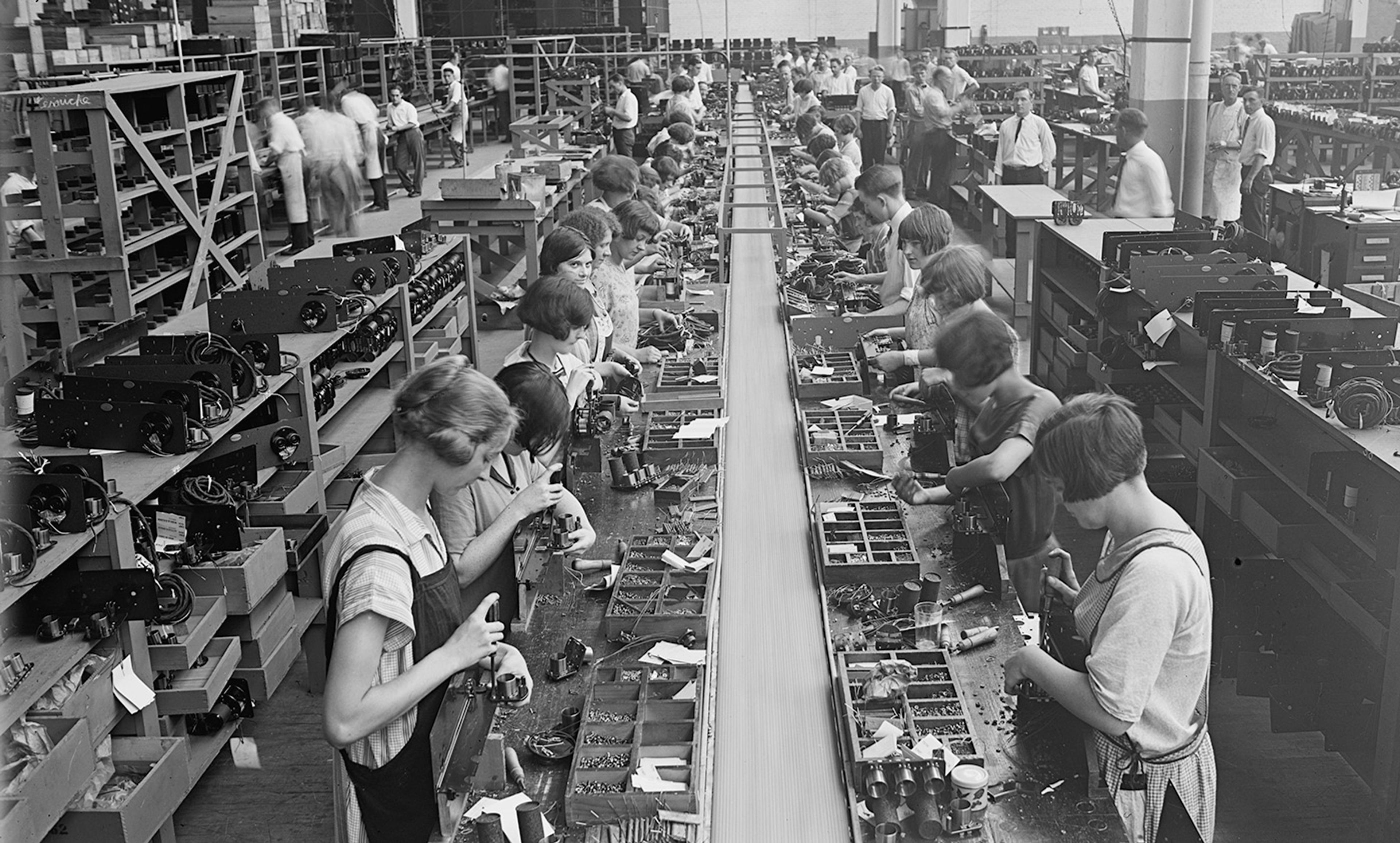Robbert Bremer/Flickr
For most of us, the industrial economy is a thing of the past. In the entire United States, large factories employ fewer than 2 million people. Even adding China to the picture does not change things much. And yet the conceptual categories of the 20th century still dominate our thinking. We remain fixated on the industrial model of economic growth, where ‘growth’ means ‘more of everything’, and we can express our rate of development in a single number. This model leads naturally to the conclusion that economic expansion must eventually run up against constraints on the availability of natural resources, such as trees to make paper.
And yet in 2013, despite positive growth overall, the world reached ‘Peak Paper’: global paper production and consumption reached its maximum, flattened out, and is now falling. A prediction that was over-hyped in the 20th century and then derided in the early 2000s – namely, the Paperless Office – is finally being realised. Growth continues, but paper is in retreat. Why did this seem so unlikely only a decade ago?
The problem is a standard assumption of macroeconomics – namely, that all sectors of the economy expand at a roughly equal rate. If this ‘fixed proportions’ assumption does not hold, the theory used to construct GDP numbers ceases to work, and the concept of a ‘rate of growth’ is no longer meaningful. Until the end of the 20th century, these assumptions did in fact work reasonably well for paper, books and newspapers. The volume of information increased somewhat more rapidly than the economy as a whole, but not so rapidly as to undermine the notion of an overall rate of economic growth. The volume of printed matter grew steadily, to around a million new books every year, and the demand for paper for printing grew in line with demand for books.
In the 21st century, for reasons too obvious to state, these relationships have broken down. While the production and consumption of paper has slowed and declined, there has been an explosion in the production and distribution of information of all kinds. That includes digital versions of traditional publications, such as e-books and online newspapers, as well as new kinds of publications such as social media. In 2010, Eric Schmidt of Google estimated that ‘Every 2 Days We Create As Much Information As We Did Up To 2003’. This claim has been the subject of some dispute, and is inevitably subject to definitional quibbles. However, it is about the right order of magnitude – and in any case, was out of date as soon as it was made. The study on which Schmidt drew estimated an annual growth rate of 50 per cent in the volume of information being generated. Extrapolating that growth rate to the present, the volume would now be around seven times as large.
This has implications reaching far beyond the confines of the paper industry. Information is now the primary engine of economic development, but we are still dealing with the intellectual legacy of the 19th and 20th centuries, when growth meant the ever-increasing use of fossil fuels to transform natural resources into goods and services of all kinds. In the 20th century, the dominant view was that this kind of growth could (and should) be carried on indefinitely. The dissenting view, epitomised by the report The Limits to Growth (1972) from the Club of Rome, held that the exhaustion of natural resources would bring growth to a catastrophic halt sometime in the 21st century.
A particularly influential version of the resource-based ‘limits to growth’ argument is that of Peak Oil. This claim begins the idea that the feasible rate at which oil can be extracted from a particular field or group of fields follows a bell-shaped curve, initially increasing, then reaching a peak (or, more realistically, a plateau), followed by an inevitable decline to zero. Extrapolating this idea to the world as a whole has led to the conclusion that its capacity to produce oil is about to reach its peak, if it has not already done so. And this is supposed to spell catastrophe. As many Peak Oil advocates would have you believe, when things start running out, the wheels necessarily come off the global economy.
The analogy with Peak Paper shows why these beliefs are false. In fact, the world reached Peak Oil in terms of consumption per person in 1979. In the developed countries, the decline in oil consumption per person has outpaced population growth with the result that total consumption is declining. The average person in a developed country now uses less oil than his parents did 40 years ago.
This remarkable change has attracted so little notice that it is worth trying to explain why. First, much of the reduction in energy use has taken the virtually invisible form of improvements in energy efficiency. Both industrial processes and household appliances use far less energy than they did in the past. Second, until fairly recently, the main substitutes for oil have been other fossil fuels such as coal and gas. It is only in the past 10 years that renewable energy sources, most notably wind and solar, have begun to play a substantial role, but this trend is now well-established.
Are these the only consumption peaks we can expect? Not at all. Peak Coal and Peak Steel have already arrived in the developed world. Coal consumption has fallen substantially in the US and Europe, and is set to fall even further. Until recently, the decline in fossil-fuel use in the developed world has been more than offset by rapid growth in developing countries. But even China – by some distance the planet’s largest coal consumer – has changed course: beginning with Beijing, it has begun closing down all the coal-fired power stations near major cities. In fact, China reached Peak Coal in 2013, at the same time as it reached Peak Paper.
The case of Peak Steel is even more interesting. Steel lasts a long time and can be recycled almost endlessly, but demand is finite. In developed countries, the stock of steel reached about eight tonnes per person decades ago, and has remained stable or declined slowly since then. With the stock of steel on a gently sloping plateau, the need for more can be met almost entirely by recycling scrap, rather than by burning coal to smelt iron ore in blast furnaces. The result has been described as a ‘circular economy’. When it arrives, Peak Steel will have been reached.
Contrary to what Peak Oil alarmists claim, these developments do not imply a reduction in living standards or an end to the process of economic development. Rather, the information economy in which we are now living allows us to break the link between improving living standards and unsustainable growth. In the process, we have the chance to realise some of the most appealing aspects of the ‘degrowth’ idea proposed by the Club of Rome. The information economy allows us to abandon the 20th-century social model in which adults spend most of their days in an organised workplace. Instead, much of the value in the information economy is generated by informal interactions through various forms of social media. Combining this trend with steadily increasing productivity makes it possible to envisage a massive reduction in formal working hours, perhaps to the 15 hours a week envisaged by Keynes nearly a century ago.
On the other hand, the world of Peak Paper is not the kibbutz archipelago of localism and self-sufficiency envisioned by the Club of Rome. Rather it is one in which people interact in many and complex ways, largely unconstrained by location. Its full implications will be hard to discern, however, until we break with the mental categories of the 20th century, and develop new ways of thinking about the information society.






